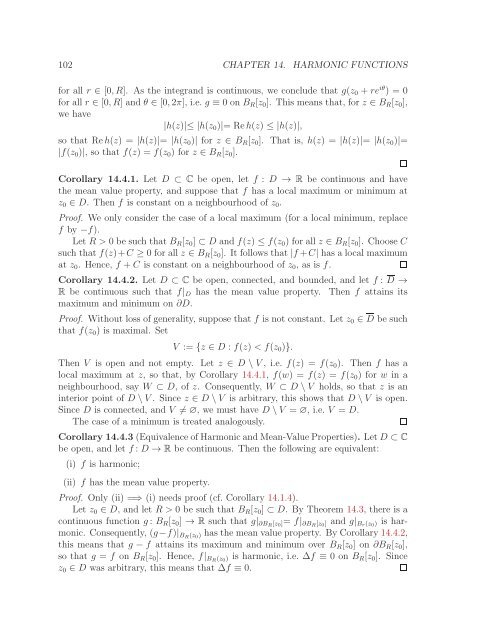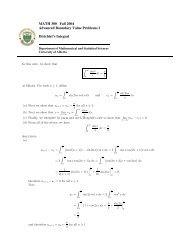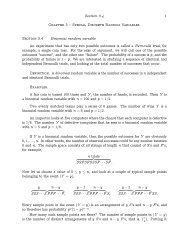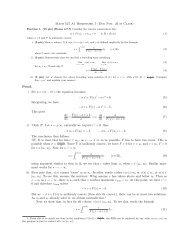Math 411: Honours Complex Variables - University of Alberta
Math 411: Honours Complex Variables - University of Alberta
Math 411: Honours Complex Variables - University of Alberta
Create successful ePaper yourself
Turn your PDF publications into a flip-book with our unique Google optimized e-Paper software.
102 CHAPTER 14. HARMONIC FUNCTIONS<br />
for all r ∈ [0,R]. As the integrand is continuous, we conclude that g(z0 +re iθ ) = 0<br />
for all r ∈ [0,R] and θ ∈ [0,2π], i.e. g ≡ 0 on BR[z0]. This means that, for z ∈ BR[z0],<br />
we have<br />
|h(z)|≤ |h(z0)|= Reh(z) ≤ |h(z)|,<br />
so that Reh(z) = |h(z)|= |h(z0)| for z ∈ BR[z0]. That is, h(z) = |h(z)|= |h(z0)|=<br />
|f(z0)|, so that f(z) = f(z0) for z ∈ BR[z0].<br />
Corollary 14.4.1. Let D ⊂ C be open, let f : D → R be continuous and have<br />
the mean value property, and suppose that f has a local maximum or minimum at<br />
z0 ∈ D. Then f is constant on a neighbourhood <strong>of</strong> z0.<br />
Pro<strong>of</strong>. We only consider the case <strong>of</strong> a local maximum (for a local minimum, replace<br />
f by −f).<br />
Let R > 0 be such that BR[z0] ⊂ D and f(z) ≤ f(z0) for all z ∈ BR[z0]. Choose C<br />
such that f(z)+C ≥ 0 for all z ∈ BR[z0]. It follows that |f+C| has a local maximum<br />
at z0. Hence, f +C is constant on a neighbourhood <strong>of</strong> z0, as is f.<br />
Corollary 14.4.2. Let D ⊂ C be open, connected, and bounded, and let f : D →<br />
R be continuous such that f|D has the mean value property. Then f attains its<br />
maximum and minimum on ∂D.<br />
Pro<strong>of</strong>. Without loss <strong>of</strong> generality, suppose that f is not constant. Let z0 ∈ D be such<br />
that f(z0) is maximal. Set<br />
V := {z ∈ D : f(z) < f(z0)}.<br />
Then V is open and not empty. Let z ∈ D \ V, i.e. f(z) = f(z0). Then f has a<br />
local maximum at z, so that, by Corollary 14.4.1, f(w) = f(z) = f(z0) for w in a<br />
neighbourhood, say W ⊂ D, <strong>of</strong> z. Consequently, W ⊂ D \V holds, so that z is an<br />
interior point <strong>of</strong> D \V. Since z ∈ D \V is arbitrary, this shows that D \V is open.<br />
Since D is connected, and V �= ∅, we must have D \V = ∅, i.e. V = D.<br />
The case <strong>of</strong> a minimum is treated analogously.<br />
Corollary 14.4.3 (Equivalence<strong>of</strong>HarmonicandMean-ValueProperties). LetD ⊂ C<br />
be open, and let f: D → R be continuous. Then the following are equivalent:<br />
(i) f is harmonic;<br />
(ii) f has the mean value property.<br />
Pro<strong>of</strong>. Only (ii) =⇒ (i) needs pro<strong>of</strong> (cf. Corollary 14.1.4).<br />
Let z0 ∈ D, and let R > 0 be such that BR[z0] ⊂ D. By Theorem 14.3, there is a<br />
continuous function g: BR[z0] → R such that g|∂BR[z0]= f|∂BR[z0] and g|Br(z0) is harmonic.<br />
Consequently, (g−f)|BR(z0) has the mean value property. By Corollary 14.4.2,<br />
this means that g − f attains its maximum and minimum over BR[z0] on ∂BR[z0],<br />
so that g = f on BR[z0]. Hence, f|BR(z0) is harmonic, i.e. ∆f ≡ 0 on BR[z0]. Since<br />
z0 ∈ D was arbitrary, this means that ∆f ≡ 0.







